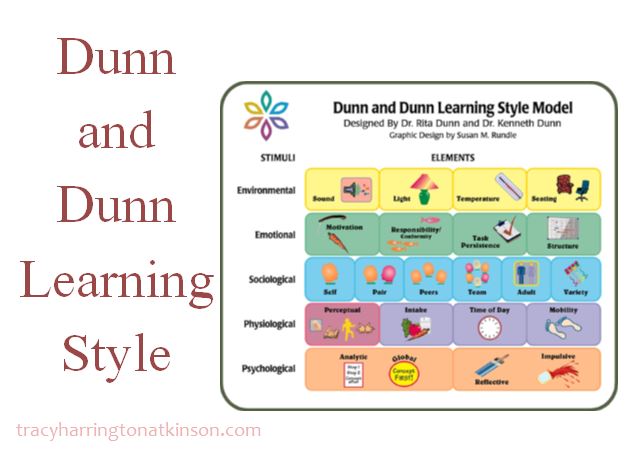Dunn and Dunn Learning Style – 1975
If the child is not learning the way you are teaching, then you must teach in the way the child learns.
~Rita Dunn
 During the 1970s, the New York State Department of Education began an initiative with the help of Kenneth and Rita Dunn to discover methods of improvements in student learning. Dunn and Dunn actively researched and developed their learning style based on over twenty years of research.
During the 1970s, the New York State Department of Education began an initiative with the help of Kenneth and Rita Dunn to discover methods of improvements in student learning. Dunn and Dunn actively researched and developed their learning style based on over twenty years of research.
Their model emphasizes the need to match an individual’s learning style with the instructional methodology used to approach teaching experiences. The matching of these two spectrums leads to higher motivation and a greater intake of knowledge for the student.
Dunn and Dunn’s learning style model looks at five different preferences including Environmental Influences, Emotional Influences, Sociological Influences, Physiological Influence and Psychological Influences.
Environmental
Environmental refers to the immediate instructional environment. Does the student prefer to learn in quiet, with music or noise? How much light do they need? What temperature is the environment and even the seating preference?
Emotional
Emotional attributes are related to the motivation, persistence and even the responsibility of the student. Is the student willing to conform to the learning task or more associated with non-conformity? What about patience and structure?
Sociological
Sociological influences impact the social preferences of the learning environment. Is the student an independent or social learner? Do they prefer to learn in pairs with peers or even in small groups? Students may even enjoy working in a variety of these options.
Physiological
Physiological concerns how the student physically engages their learning environment. What are their perceptual preferences (visual, audio, kinesthetic, read/write)? What time of the day are they most effective as learners? Do they need to be moving to learn? Hands-on learner? Or maybe they are a passive learner who simply prefers to observe.
Psychological
How the learner processes and responds to information and ideas is related to the psychological influences. Are they detail oriented? Global oriented? Reflective?
Of course, the Dunn and Dunn Learning Styles possesses strengths and weaknesses.
By Tracy Atkinson
 Tracy Atkinson, mother of six, lives in the Midwest with her husband and spirited long-haired miniature dachshunds. She is a teacher, having taught elementary school to higher education, holding degrees in elementary education and a master’s in higher education. Her passion is researching, studying and investigating the attributes related to self-directed learners and learning styles. She has published several titles, including MBTI Learning Styles: A Practical Approach, The Art of Learning Journals, Calais: The Annals of the Hidden, Lemosa: The Annals of the Hidden, Book Two, Rachel’s 8, The Personal Pursuit of Perfection and Securing Your Tent. She is currently working on a non-fiction text exploring the attributes of self-directed learners: The Five Characteristics of Self-directed Learners. Check out her online courses at: Udemy, Teachable and Thinkific.
Tracy Atkinson, mother of six, lives in the Midwest with her husband and spirited long-haired miniature dachshunds. She is a teacher, having taught elementary school to higher education, holding degrees in elementary education and a master’s in higher education. Her passion is researching, studying and investigating the attributes related to self-directed learners and learning styles. She has published several titles, including MBTI Learning Styles: A Practical Approach, The Art of Learning Journals, Calais: The Annals of the Hidden, Lemosa: The Annals of the Hidden, Book Two, Rachel’s 8, The Personal Pursuit of Perfection and Securing Your Tent. She is currently working on a non-fiction text exploring the attributes of self-directed learners: The Five Characteristics of Self-directed Learners. Check out her online courses at: Udemy, Teachable and Thinkific.

Comments are closed